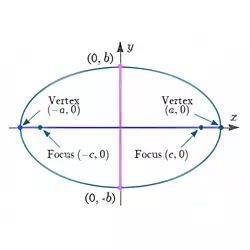
Ellipse

In analytic geometry, an ellipse is a mathematical equation that, when graphed, resembles an egg. An ellipse has two focal points. The distance apart between the two points is one way of describing a particular ellipse. If the two points come together the ellipses become a circle with the point at its center.
Ellipse with center at the origin
Ellipse with center at the origin and major axis on the x-axis.
$$ \frac {x^2}{a^2} + \frac {y^2}{b^2} = 1 $$

Ellipse with center at the origin and major axis on the y-axis.
$$ \frac {x^2}{b^2} + \frac {y^2}{a^2} = 1 $$
Ellipse with center at (h, k):
Ellipse with center at (h, k) and major axis parallel to the x-axis.
$$ \frac {(x-h)^2}{a^2} + \frac {(y-k)^2}{b^2} = 1 $$
Ellipse with center at (h, k) and major axis parallel to the y-axis.
$$ \frac {(x-h)^2}{b^2} + \frac {(y-k)^2}{a^2} = 1 $$
Example:
What is the standard form equation of the ellipse that has vertices (±8,0) and foci (±5,0)?
The foci are on the x-axis, so the major axis is the x-axis. Thus, the equation will have the form
$$ \frac {x^2}{a^2} + \frac {y^2}{b^2} = 1 $$
The vertices are (±8,0), so a=8 and a2=64
The foci are (±5,0), so c=5 and c2=25
We know that the vertices and foci are related by the equation c2=a2-b2. solving for b2, we have:
$$ 25=64-b^2 $$
$$ b^2=39 $$
The equation of the ellipse is
$$ \frac {x^2}{64} + \frac {y^2}{39} = 1 $$
Elements of Hyperbola:
Center:
The center of the ellipse has coordinates (h,k).
Major Axis:
The major axis of the ellipse is the longest width across it. For a horizontal ellipse, that axis is parallel to the x-axis. The major axis has length 2a. Its endpoints are the major axis vertices, with coordinates (h±a,k).
Minor Axis:
The minor axis of the ellipse is the shortest width across it. For a horizontal ellipse, it is parallel to the y-axis. The minor axis has length 2b. Its endpoints are the minor axis vertices, with coordinates (h,k±b).
Foci:
The foci are two points inside the ellipse that characterize its shape and curvature. For a horizontal ellipse, the foci have coordinates (h±c,k), where the focal length c is given by
$$ c^2=a^2-b^2 $$
Eccentricity:
All conic sections have an eccentricity value, denoted e. All ellipses have eccentricities in the range 0≤e<1. An eccentricity of zero is the special case where the ellipse becomes a circle. An eccentricity of 1 is a parabola, not an ellipse.
The eccentricity is defined as:
$$ e= \frac ca $$
Example:
Find the coordinates of the vertices and foci of 25x2+y2=25
$$ x^2 + \frac {y^2}{25} =1 $$
So b=1 and a=5. In this example, the major axis is vertical.
So the vertices are at (0,-5) and (0,5).
To find c, we proceed as before:
$$ c= \sqrt {a^2-b^2} $$
$$ = \sqrt {25-1} $$
$$ = \sqrt {24} $$
$$ c= 4.899 $$
So the foci are at (0,-4.9) and (0,4.9).


